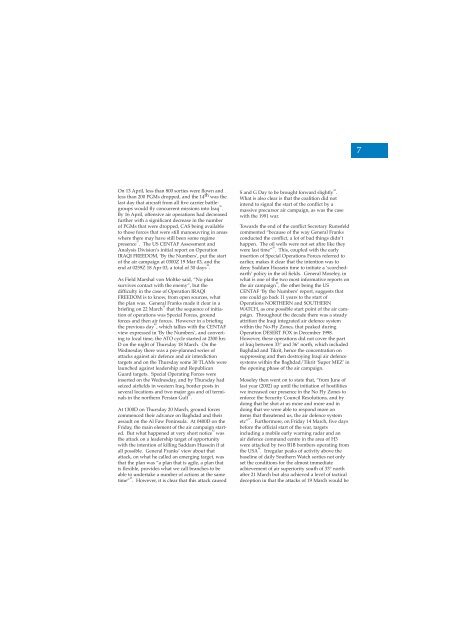Volume 6 No 4 - Royal Air Force Centre for Air Power Studies
Volume 6 No 4 - Royal Air Force Centre for Air Power Studies
Volume 6 No 4 - Royal Air Force Centre for Air Power Studies
You also want an ePaper? Increase the reach of your titles
YUMPU automatically turns print PDFs into web optimized ePapers that Google loves.
7<br />
On 13 April, less than 800 sorties were flown and<br />
less than 200 PGMs dropped, and the 14 th was the<br />
last day that aircraft from all five carrier battlegroups<br />
would fly concurrent missions into Iraq 36 .<br />
By 16 April, offensive air operations had decreased<br />
further with a significant decrease in the number<br />
of PGMs that were dropped, CAS being available<br />
to those <strong>for</strong>ces that were still manoeuvring in areas<br />
where there may have still been some regime<br />
presence 37 . The US CENTAF Assessment and<br />
Analysis Division’s initial report on Operation<br />
IRAQI FREEDOM, ‘By the Numbers’, put the start<br />
of the air campaign at 0300Z 19 Mar 03, and the<br />
end at 0259Z 18 Apr 03, a total of 30 days 38 .<br />
As Field Marshal von Moltke said, “<strong>No</strong> plan<br />
survives contact with the enemy”, but the<br />
difficulty in the case of Operation IRAQI<br />
FREEDOM is to know, from open sources, what<br />
the plan was. General Franks made it clear in a<br />
briefing on 22 March 39 that the sequence of initiation<br />
of operations was Special <strong>Force</strong>s, ground<br />
<strong>for</strong>ces and then air <strong>for</strong>ces. However in a briefing<br />
the previous day 40 , which tallies with the CENTAF<br />
view expressed in ‘By the Numbers’, and converting<br />
to local time, the ATO cycle started at 2300 hrs<br />
D on the night of Thursday 18 March. On the<br />
Wednesday there was a pre-planned series of<br />
attacks against air defence and air interdiction<br />
targets and on the Thursday some 30 TLAMs were<br />
launched against leadership and Republican<br />
Guard targets. Special Operating <strong>Force</strong>s were<br />
inserted on the Wednesday, and by Thursday had<br />
seized airfields in western Iraq, border posts in<br />
several locations and two major gas and oil terminals<br />
in the northern Persian Gulf 41 .<br />
At 1300D on Thursday 20 March, ground <strong>for</strong>ces<br />
commenced their advance on Baghdad and their<br />
assault on the Al Faw Peninsula. At 0400D on the<br />
Friday, the main element of the air campaign started.<br />
But what happened at very short notice 42 was<br />
the attack on a leadership target of opportunity<br />
with the intention of killing Saddam Hussein if at<br />
all possible. General Franks’ view about that<br />
attack, on what he called an emerging target, was<br />
that the plan was “a plan that is agile, a plan that<br />
is flexible, provides what we call branches to be<br />
able to undertake a number of actions at the same<br />
time” 43 . However, it is clear that this attack caused<br />
S and G Day to be brought <strong>for</strong>ward slightly 44 .<br />
What is also clear is that the coalition did not<br />
intend to signal the start of the conflict by a<br />
massive precursor air campaign, as was the case<br />
with the 1991 war.<br />
Towards the end of the conflict Secretary Rumsfeld<br />
commented “because of the way General Franks<br />
conducted the conflict, a lot of bad things didn’t<br />
happen. The oil wells were not set afire like they<br />
were last time” 45 . This, coupled with the early<br />
insertion of Special Operations <strong>Force</strong>s referred to<br />
earlier, makes it clear that the intention was to<br />
deny Saddam Hussein time to initiate a ‘scorchedearth’<br />
policy in the oil fields. General Moseley, in<br />
what is one of the two most in<strong>for</strong>mative reports on<br />
the air campaign 46 , the other being the US<br />
CENTAF ‘By the Numbers’ report, suggests that<br />
one could go back 11 years to the start of<br />
Operations NORTHERN and SOUTHERN<br />
WATCH, as one possible start point of the air campaign.<br />
Throughout the decade there was a steady<br />
attrition the Iraqi integrated air defence system<br />
within the <strong>No</strong>-Fly Zones, that peaked during<br />
Operation DESERT FOX in December 1998.<br />
However, these operations did not cover the part<br />
of Iraq between 33° and 36° north, which included<br />
Baghdad and Tikrit, hence the concentration on<br />
suppressing and then destroying Iraqi air defence<br />
systems within the Baghdad/Tikrit ‘Super MEZ’ in<br />
the opening phase of the air campaign.<br />
Moseley then went on to state that, “from June of<br />
last year (2002) up until the initiation of hostilities<br />
we increased our presence in the <strong>No</strong> Fly Zones to<br />
en<strong>for</strong>ce the Security Council Resolutions, and by<br />
doing that he shot at us more and more and in<br />
doing that we were able to respond more on<br />
items that threatened us, the air defence system<br />
etc” 47 . Furthermore, on Friday 14 March, five days<br />
be<strong>for</strong>e the official start of the war, targets<br />
including a mobile early warning radar and an<br />
air defence command centre in the area of H3<br />
were attacked by two B1B bombers operating from<br />
the USA 48 . Irregular peaks of activity above the<br />
baseline of daily Southern Watch sorties not only<br />
set the conditions <strong>for</strong> the almost immediate<br />
achievement of air superiority south of 33° north<br />
after 21 March but also achieved a level of tactical<br />
deception in that the attacks of 19 March would be
















